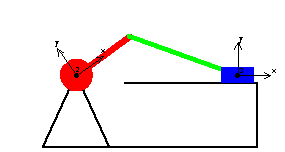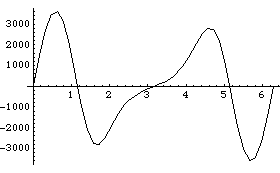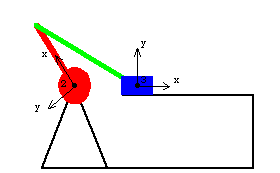11.2.3 Slider-Crank Example MechanismTo demonstrate the use of the Reaction and Loads functions with generalized coordinates a planar model of a simple slider-crank mechanism is developed. This model uses only two bodies, the slider and crank, and it is modeled with two generalized coordinates, the rotation angle of the crank and the X displacement of the slider. This loads the Modeler2D packages and defines some useful constants. Here is the slider-crank mechanism.

Bodies Two body objects are defined for the slider-crank model. Inertia properties are defined for each moving body so that the dynamic reaction forces can be calculated. No local point definitions are made in the body objects. All necessary point coordinates in this model are given explicitly in the constraint functions. Here are the body objects for the slider-crank model. The body properties are incorporated into the model. ConstraintsFour constraints are used to model the slider-crank mechanism. Two generalized coordinate constraints are used along with two standard constraints. A GenRevolute2 constraint defines the symbol alpha as the angular coordinate of the crank.A RotationLock1 constraint controls the rotation of the crank.A GenTranslate2 constraint defines the symbol beta as the displacement coordinate of the slider.A RelativeDistance1 constraint models the connecting rod between the crank and the slider.Here are the constraint objects for the slider-crank mechanism. The constraints are incorporated into the current model. LoadsA force that is a linear function of slider position is applied to the slider to simulate a simple spring. The spring has a spring constant of 10, and it is placed so that the spring force is zero when the X displacement of the slider is three units. Here is a spring force applied to the slider. The model is run at T = 0.1 with the Static option to cause the Lagrange multipliers to be calculated.
Out[22]= |  |
ReactionsBecause generalized coordinates were used in this model, Mech's ability to find constraint reaction forces is limited. Normally, Reaction could be used to find the reaction force vector that the revolute joint applies to the crank, but with this model only the moment applied to the crank by constraint 2 can be found. Note that Reaction cannot directly find the moment applied to body 2, it can only find the generalized force associated with the symbol alpha. Since alpha is an angular coordinate, its associated load is a moment. Here is the moment applied to the crank by the driving constraint.
Out[23]= |  |
Of course constraint 4, the RelativeDistance1 constraint, applies an equal and opposite moment to the crank. Here is the moment applied to the crank by the connecting rod.
Out[24]= |  |
Out[25]= |  |
Constraint 4 also applies a reaction force to the slider. Again, the restraining force and torque that would be applied to the slider by a normal Translate2 constraint cannot be found. Only the generalized force associated with beta can be found, which is the X direction force on the slider. Here is the force applied to the slider by the connecting rod.
Out[26]= |  |
Here are the external loads applied to the coordinates alpha and beta.
Out[27]= |  |
The inertia terms are automatically converted into the proper coordinate system so that the dynamic reaction forces may be calculated. The Solution -> Dynamic option causes SolveMech to include the inertial loads and calculate the reaction forces. Here is a plot of the torque required to drive the crank through a full cycle.

Out[28]= |  |
Here is the graphics function that generates the image of the slider-crank mechanism. Here is the slider-crank mechanism at T = 0.35.

Out[30]= |  |
|